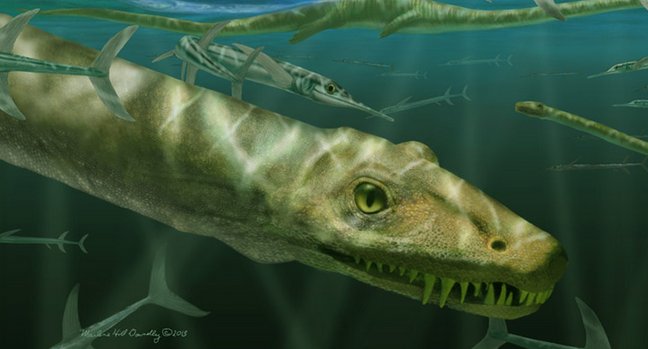For a couple days now, we have been in the Year of the Dragon according to the Chinese lunar calendar. Fittingly, an international research team, including palaeontologist Dr. Stephan Spiekman, published a new study on Chinese fossil remains of a truly bizarre marine reptile: Dinocephalosaurus orientalis. This animal, now thoroughly described for the first time, has an extraordinarily long neck and an elongate, snake-like body, with short legs, bearing a striking resemblance to the classical representation of the dragon in Chinese mythology.
The first fossils of Dinocephalosaurus were discovered and studied back in 2003 in the Chinese province of Guizhou. Further discoveries have enabled scientists to gain an even better picture of this unusual, roughly 240 million year old reptile. The current study summarizes the results of the last ten years of research on already known as well as newly discovered fossil material of Dinocephalosaurus and presents a detailed description of its unique anatomy.
A body length of up to six meters is nothing special for marine reptiles from the Triassic period. However, things change when the neck alone accounts for almost half of that length. This is otherwise only known from Tanystropheus which lived only a few million years later and whose remains can be found in Germany too. At first glance, it would have been easy to confuse these two animals. However, there are key differences: While the neck of Tanystropheus consists of only 13 greatly elongated cervical vertebrae, Dinocephalosaurus has 32! Although both are related to each other, their long necks apparently evolved independently from one another.
Dinocephalosaurus was very well adapted to life in the open sea. It possesed fin-like limbs and its mouth was full of sharp teeth with which it could prey on fish, which have been found in the stomach contents of one of the fossils. Another fossil preserves a well-developed embryo within its body cavity, suggesting Dinocephalosaurus gave birth to live young, rather than going back onto land to lay eggs, and showing how well-adapted it was to life in water. Of course, it is not a dragon from Chinese mythology. Nevertheless, fossils like these certainly might have fueled people's imaginations thousands of years ago.
Both Dinocephalosaurus and its close relatives became extinct by the end of the Triassic period 200 million years ago. Further research is needed to better understand the evolution of this bizarre group of animals, which, in addition to the two long-necked marine reptiles, also gave rise to a number of land-dwelling and possibly even gliding species.
